Analysis of Chronic Illness: WHO Models, Australian Health Priorities
VerifiedAdded on 2023/06/18
|9
|2121
|182
Report
AI Summary
This report provides a detailed overview of chronic illnesses, focusing on various models of care, including the WHO model, Stanford model, and Flinders model. It highlights Australian health priorities for chronic diseases such as cardiovascular disease, cancer, and mental health. The report also explores the continuum of chronic disease, from at-risk individuals to those with co-morbidities, and discusses the life variables impacting health and well-being, such as socio-economic status and education. Furthermore, it addresses the impacts of chronic diseases on the Australian population, including mental health conditions, back problems, and cardiovascular diseases. The report concludes by emphasizing the importance of effective chronic disease management and the establishment of health priorities within the Australian healthcare system. Desklib offers a range of study tools and resources for students.

Chronic Illness
Paraphrase This Document
Need a fresh take? Get an instant paraphrase of this document with our AI Paraphraser
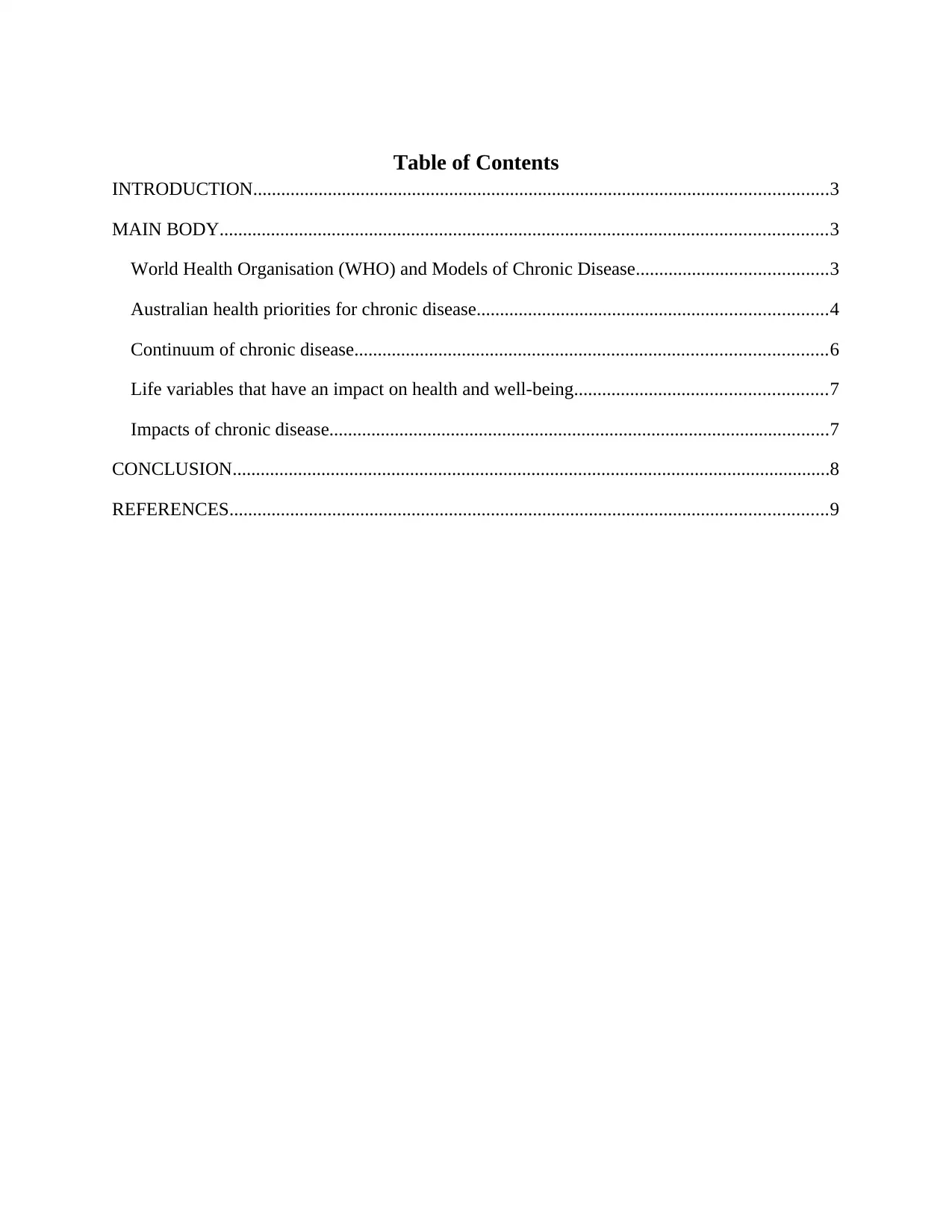
Table of Contents
INTRODUCTION...........................................................................................................................3
MAIN BODY..................................................................................................................................3
World Health Organisation (WHO) and Models of Chronic Disease.........................................3
Australian health priorities for chronic disease...........................................................................4
Continuum of chronic disease.....................................................................................................6
Life variables that have an impact on health and well-being......................................................7
Impacts of chronic disease...........................................................................................................7
CONCLUSION................................................................................................................................8
REFERENCES................................................................................................................................9
INTRODUCTION...........................................................................................................................3
MAIN BODY..................................................................................................................................3
World Health Organisation (WHO) and Models of Chronic Disease.........................................3
Australian health priorities for chronic disease...........................................................................4
Continuum of chronic disease.....................................................................................................6
Life variables that have an impact on health and well-being......................................................7
Impacts of chronic disease...........................................................................................................7
CONCLUSION................................................................................................................................8
REFERENCES................................................................................................................................9

INTRODUCTION
Chronic illness can be defined as any illness or disease that last 1 year and more and
require ongoing medical attention and is also likely to limit daily activities for patient. Heart
disease, cancer and diabetes are few examples of chronic disease Dowaidar, M. (2021). This
study will discuss about WHO and other models of chronic disease, Australian health priority for
chronic disease, continuum of chronic disease and life variables having impact on chronic
disease will also be discussed in report. Chronic disease that have impact on lives of people all
around the world and among those who die from chronic disease four out of five are from low
and middle income countries. Chronic health condition being considered for this assessment is
cancer.
MAIN BODY
World Health Organisation (WHO) and Models of Chronic Disease
There are several models for care that enables to effectively deal with chronic disease and
these models include WHO Model of care, Stanford Model of Chronic Health Disorders,
Flinders Model of Chronic Health Disorders and Chronic Care Model (CCM). Challenges of
healthcare care system of Australia involves-
Demographic changes and increasing ageing population
Cost of technology for healthcare system
Public and private funding for healthcare
Equity issues and issues related to health inequality
WHO model of Care also known as Innovative Care for Chronic Conditions Framework
The Innovative Care for Chronic Conditions Framework (ICCC) framework is comprised
of micro, meso, and macro factors. Micro factors involve patient, meso factor involves
healthcare organisation and community and macro factors include policies. These three
components are known as building blocks that can be used for creating healthcare system
capable of managing cancer effectively. This model connects three essential elements involved
3
Chronic illness can be defined as any illness or disease that last 1 year and more and
require ongoing medical attention and is also likely to limit daily activities for patient. Heart
disease, cancer and diabetes are few examples of chronic disease Dowaidar, M. (2021). This
study will discuss about WHO and other models of chronic disease, Australian health priority for
chronic disease, continuum of chronic disease and life variables having impact on chronic
disease will also be discussed in report. Chronic disease that have impact on lives of people all
around the world and among those who die from chronic disease four out of five are from low
and middle income countries. Chronic health condition being considered for this assessment is
cancer.
MAIN BODY
World Health Organisation (WHO) and Models of Chronic Disease
There are several models for care that enables to effectively deal with chronic disease and
these models include WHO Model of care, Stanford Model of Chronic Health Disorders,
Flinders Model of Chronic Health Disorders and Chronic Care Model (CCM). Challenges of
healthcare care system of Australia involves-
Demographic changes and increasing ageing population
Cost of technology for healthcare system
Public and private funding for healthcare
Equity issues and issues related to health inequality
WHO model of Care also known as Innovative Care for Chronic Conditions Framework
The Innovative Care for Chronic Conditions Framework (ICCC) framework is comprised
of micro, meso, and macro factors. Micro factors involve patient, meso factor involves
healthcare organisation and community and macro factors include policies. These three
components are known as building blocks that can be used for creating healthcare system
capable of managing cancer effectively. This model connects three essential elements involved
3
⊘ This is a preview!⊘
Do you want full access?
Subscribe today to unlock all pages.

Trusted by 1+ million students worldwide
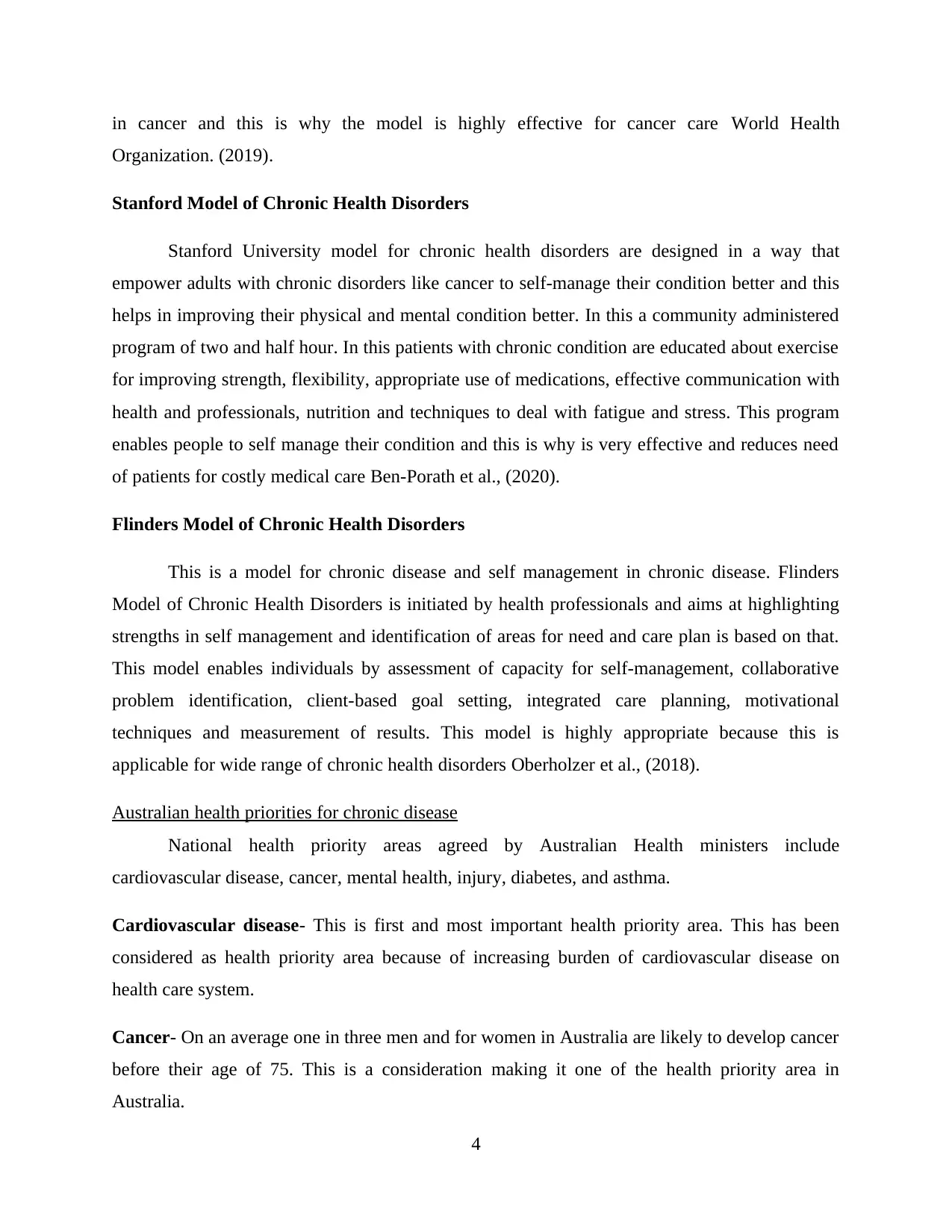
in cancer and this is why the model is highly effective for cancer care World Health
Organization. (2019).
Stanford Model of Chronic Health Disorders
Stanford University model for chronic health disorders are designed in a way that
empower adults with chronic disorders like cancer to self-manage their condition better and this
helps in improving their physical and mental condition better. In this a community administered
program of two and half hour. In this patients with chronic condition are educated about exercise
for improving strength, flexibility, appropriate use of medications, effective communication with
health and professionals, nutrition and techniques to deal with fatigue and stress. This program
enables people to self manage their condition and this is why is very effective and reduces need
of patients for costly medical care Ben-Porath et al., (2020).
Flinders Model of Chronic Health Disorders
This is a model for chronic disease and self management in chronic disease. Flinders
Model of Chronic Health Disorders is initiated by health professionals and aims at highlighting
strengths in self management and identification of areas for need and care plan is based on that.
This model enables individuals by assessment of capacity for self-management, collaborative
problem identification, client-based goal setting, integrated care planning, motivational
techniques and measurement of results. This model is highly appropriate because this is
applicable for wide range of chronic health disorders Oberholzer et al., (2018).
Australian health priorities for chronic disease
National health priority areas agreed by Australian Health ministers include
cardiovascular disease, cancer, mental health, injury, diabetes, and asthma.
Cardiovascular disease- This is first and most important health priority area. This has been
considered as health priority area because of increasing burden of cardiovascular disease on
health care system.
Cancer- On an average one in three men and for women in Australia are likely to develop cancer
before their age of 75. This is a consideration making it one of the health priority area in
Australia.
4
Organization. (2019).
Stanford Model of Chronic Health Disorders
Stanford University model for chronic health disorders are designed in a way that
empower adults with chronic disorders like cancer to self-manage their condition better and this
helps in improving their physical and mental condition better. In this a community administered
program of two and half hour. In this patients with chronic condition are educated about exercise
for improving strength, flexibility, appropriate use of medications, effective communication with
health and professionals, nutrition and techniques to deal with fatigue and stress. This program
enables people to self manage their condition and this is why is very effective and reduces need
of patients for costly medical care Ben-Porath et al., (2020).
Flinders Model of Chronic Health Disorders
This is a model for chronic disease and self management in chronic disease. Flinders
Model of Chronic Health Disorders is initiated by health professionals and aims at highlighting
strengths in self management and identification of areas for need and care plan is based on that.
This model enables individuals by assessment of capacity for self-management, collaborative
problem identification, client-based goal setting, integrated care planning, motivational
techniques and measurement of results. This model is highly appropriate because this is
applicable for wide range of chronic health disorders Oberholzer et al., (2018).
Australian health priorities for chronic disease
National health priority areas agreed by Australian Health ministers include
cardiovascular disease, cancer, mental health, injury, diabetes, and asthma.
Cardiovascular disease- This is first and most important health priority area. This has been
considered as health priority area because of increasing burden of cardiovascular disease on
health care system.
Cancer- On an average one in three men and for women in Australia are likely to develop cancer
before their age of 75. This is a consideration making it one of the health priority area in
Australia.
4
Paraphrase This Document
Need a fresh take? Get an instant paraphrase of this document with our AI Paraphraser
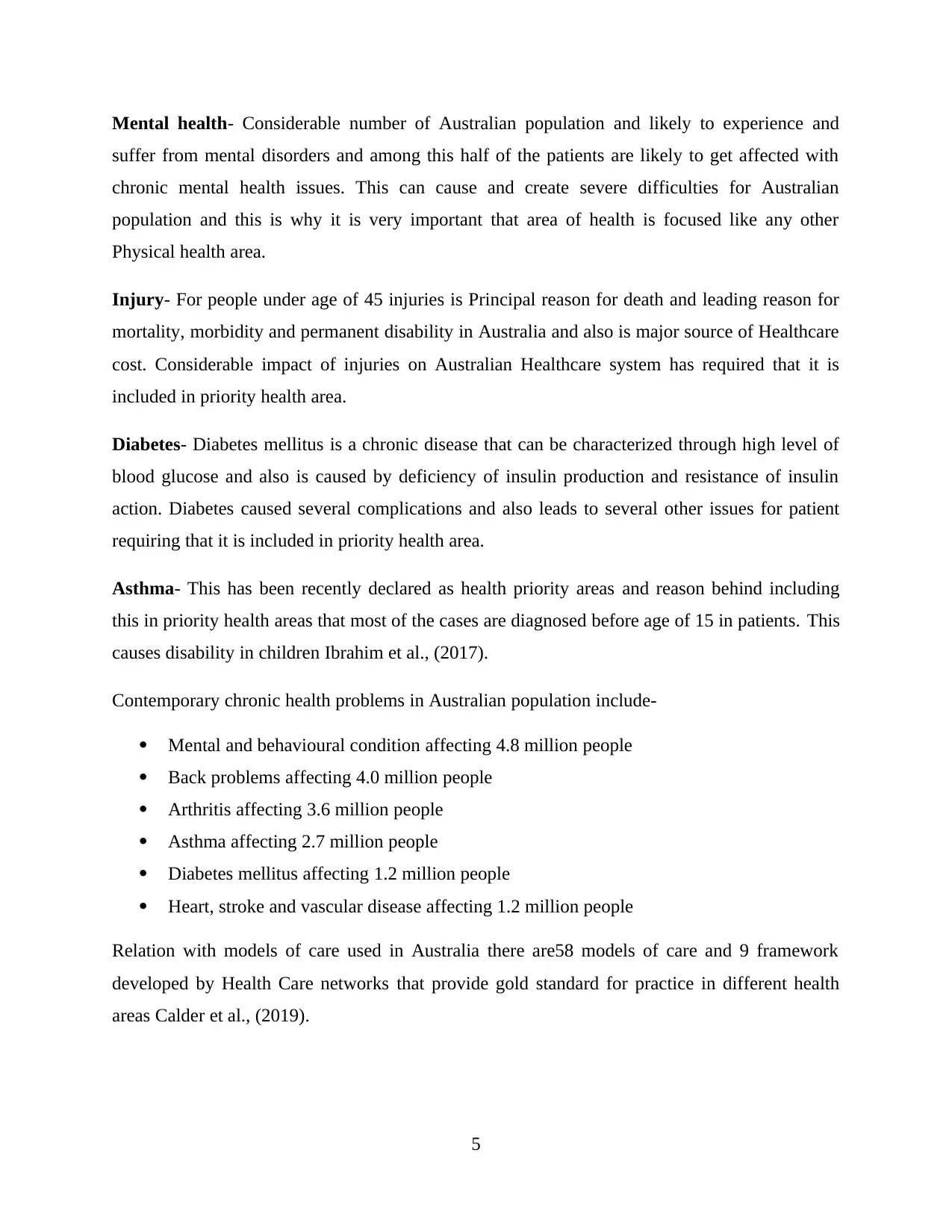
Mental health- Considerable number of Australian population and likely to experience and
suffer from mental disorders and among this half of the patients are likely to get affected with
chronic mental health issues. This can cause and create severe difficulties for Australian
population and this is why it is very important that area of health is focused like any other
Physical health area.
Injury- For people under age of 45 injuries is Principal reason for death and leading reason for
mortality, morbidity and permanent disability in Australia and also is major source of Healthcare
cost. Considerable impact of injuries on Australian Healthcare system has required that it is
included in priority health area.
Diabetes- Diabetes mellitus is a chronic disease that can be characterized through high level of
blood glucose and also is caused by deficiency of insulin production and resistance of insulin
action. Diabetes caused several complications and also leads to several other issues for patient
requiring that it is included in priority health area.
Asthma- This has been recently declared as health priority areas and reason behind including
this in priority health areas that most of the cases are diagnosed before age of 15 in patients. This
causes disability in children Ibrahim et al., (2017).
Contemporary chronic health problems in Australian population include-
Mental and behavioural condition affecting 4.8 million people
Back problems affecting 4.0 million people
Arthritis affecting 3.6 million people
Asthma affecting 2.7 million people
Diabetes mellitus affecting 1.2 million people
Heart, stroke and vascular disease affecting 1.2 million people
Relation with models of care used in Australia there are58 models of care and 9 framework
developed by Health Care networks that provide gold standard for practice in different health
areas Calder et al., (2019).
5
suffer from mental disorders and among this half of the patients are likely to get affected with
chronic mental health issues. This can cause and create severe difficulties for Australian
population and this is why it is very important that area of health is focused like any other
Physical health area.
Injury- For people under age of 45 injuries is Principal reason for death and leading reason for
mortality, morbidity and permanent disability in Australia and also is major source of Healthcare
cost. Considerable impact of injuries on Australian Healthcare system has required that it is
included in priority health area.
Diabetes- Diabetes mellitus is a chronic disease that can be characterized through high level of
blood glucose and also is caused by deficiency of insulin production and resistance of insulin
action. Diabetes caused several complications and also leads to several other issues for patient
requiring that it is included in priority health area.
Asthma- This has been recently declared as health priority areas and reason behind including
this in priority health areas that most of the cases are diagnosed before age of 15 in patients. This
causes disability in children Ibrahim et al., (2017).
Contemporary chronic health problems in Australian population include-
Mental and behavioural condition affecting 4.8 million people
Back problems affecting 4.0 million people
Arthritis affecting 3.6 million people
Asthma affecting 2.7 million people
Diabetes mellitus affecting 1.2 million people
Heart, stroke and vascular disease affecting 1.2 million people
Relation with models of care used in Australia there are58 models of care and 9 framework
developed by Health Care networks that provide gold standard for practice in different health
areas Calder et al., (2019).
5
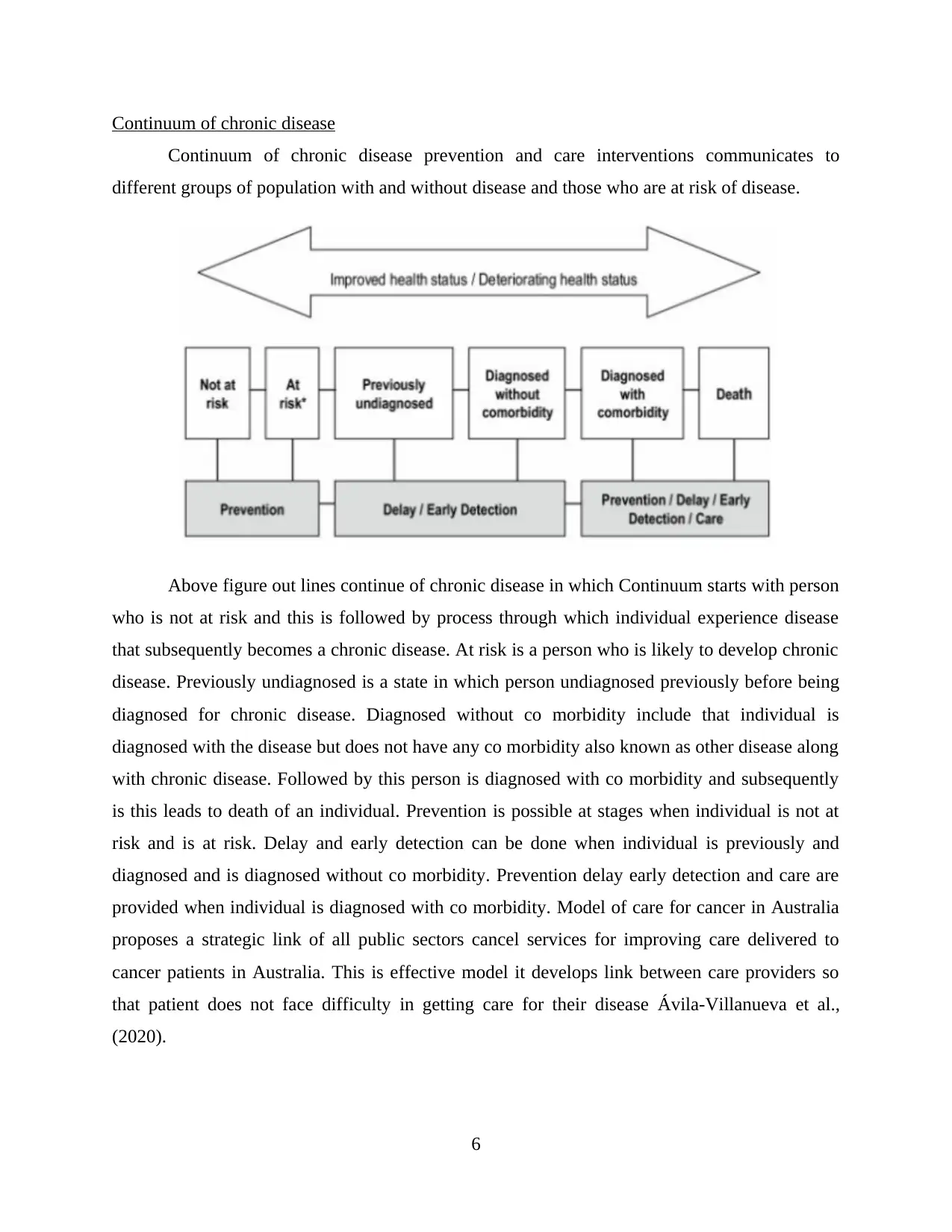
Continuum of chronic disease
Continuum of chronic disease prevention and care interventions communicates to
different groups of population with and without disease and those who are at risk of disease.
Above figure out lines continue of chronic disease in which Continuum starts with person
who is not at risk and this is followed by process through which individual experience disease
that subsequently becomes a chronic disease. At risk is a person who is likely to develop chronic
disease. Previously undiagnosed is a state in which person undiagnosed previously before being
diagnosed for chronic disease. Diagnosed without co morbidity include that individual is
diagnosed with the disease but does not have any co morbidity also known as other disease along
with chronic disease. Followed by this person is diagnosed with co morbidity and subsequently
is this leads to death of an individual. Prevention is possible at stages when individual is not at
risk and is at risk. Delay and early detection can be done when individual is previously and
diagnosed and is diagnosed without co morbidity. Prevention delay early detection and care are
provided when individual is diagnosed with co morbidity. Model of care for cancer in Australia
proposes a strategic link of all public sectors cancel services for improving care delivered to
cancer patients in Australia. This is effective model it develops link between care providers so
that patient does not face difficulty in getting care for their disease Ávila-Villanueva et al.,
(2020).
6
Continuum of chronic disease prevention and care interventions communicates to
different groups of population with and without disease and those who are at risk of disease.
Above figure out lines continue of chronic disease in which Continuum starts with person
who is not at risk and this is followed by process through which individual experience disease
that subsequently becomes a chronic disease. At risk is a person who is likely to develop chronic
disease. Previously undiagnosed is a state in which person undiagnosed previously before being
diagnosed for chronic disease. Diagnosed without co morbidity include that individual is
diagnosed with the disease but does not have any co morbidity also known as other disease along
with chronic disease. Followed by this person is diagnosed with co morbidity and subsequently
is this leads to death of an individual. Prevention is possible at stages when individual is not at
risk and is at risk. Delay and early detection can be done when individual is previously and
diagnosed and is diagnosed without co morbidity. Prevention delay early detection and care are
provided when individual is diagnosed with co morbidity. Model of care for cancer in Australia
proposes a strategic link of all public sectors cancel services for improving care delivered to
cancer patients in Australia. This is effective model it develops link between care providers so
that patient does not face difficulty in getting care for their disease Ávila-Villanueva et al.,
(2020).
6
⊘ This is a preview!⊘
Do you want full access?
Subscribe today to unlock all pages.

Trusted by 1+ million students worldwide
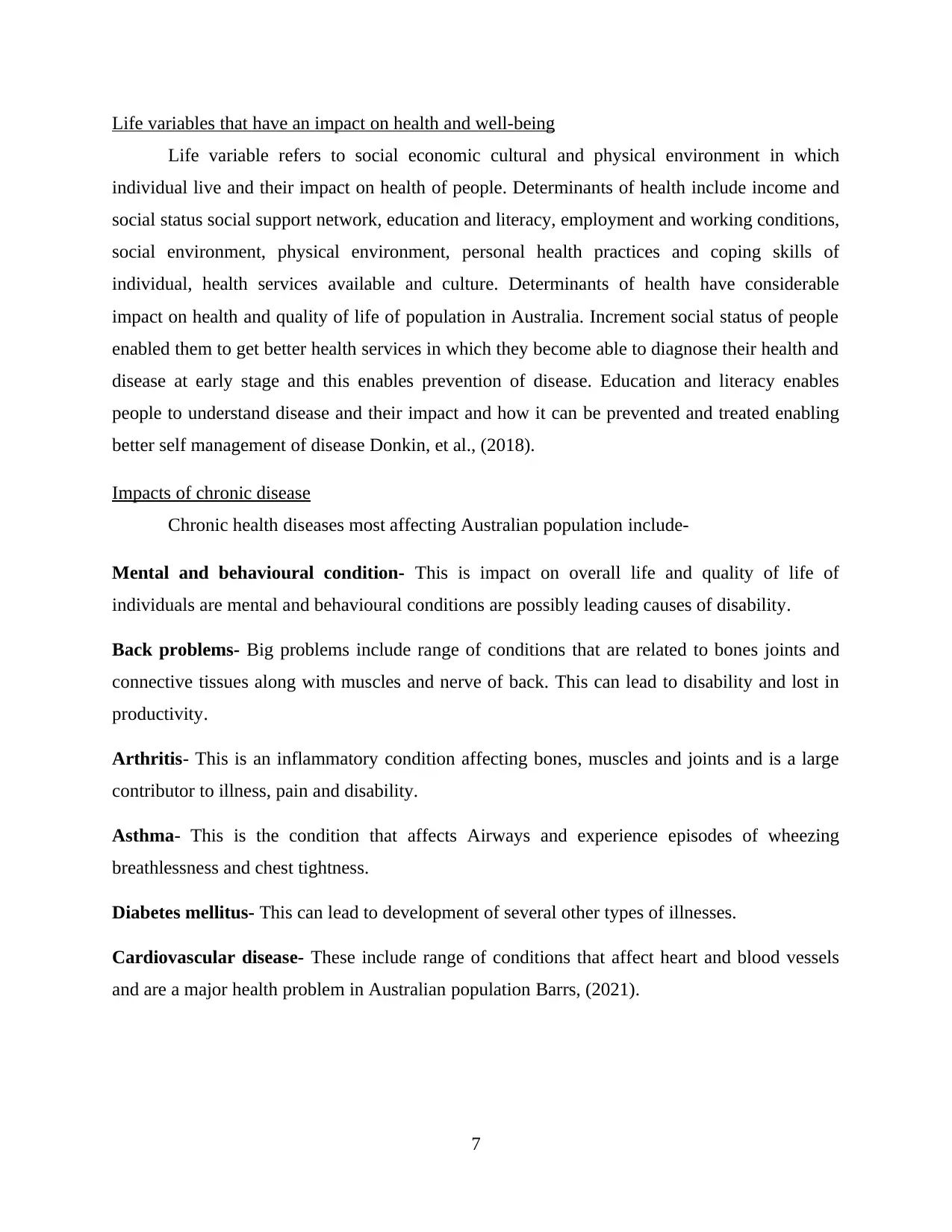
Life variables that have an impact on health and well-being
Life variable refers to social economic cultural and physical environment in which
individual live and their impact on health of people. Determinants of health include income and
social status social support network, education and literacy, employment and working conditions,
social environment, physical environment, personal health practices and coping skills of
individual, health services available and culture. Determinants of health have considerable
impact on health and quality of life of population in Australia. Increment social status of people
enabled them to get better health services in which they become able to diagnose their health and
disease at early stage and this enables prevention of disease. Education and literacy enables
people to understand disease and their impact and how it can be prevented and treated enabling
better self management of disease Donkin, et al., (2018).
Impacts of chronic disease
Chronic health diseases most affecting Australian population include-
Mental and behavioural condition- This is impact on overall life and quality of life of
individuals are mental and behavioural conditions are possibly leading causes of disability.
Back problems- Big problems include range of conditions that are related to bones joints and
connective tissues along with muscles and nerve of back. This can lead to disability and lost in
productivity.
Arthritis- This is an inflammatory condition affecting bones, muscles and joints and is a large
contributor to illness, pain and disability.
Asthma- This is the condition that affects Airways and experience episodes of wheezing
breathlessness and chest tightness.
Diabetes mellitus- This can lead to development of several other types of illnesses.
Cardiovascular disease- These include range of conditions that affect heart and blood vessels
and are a major health problem in Australian population Barrs, (2021).
7
Life variable refers to social economic cultural and physical environment in which
individual live and their impact on health of people. Determinants of health include income and
social status social support network, education and literacy, employment and working conditions,
social environment, physical environment, personal health practices and coping skills of
individual, health services available and culture. Determinants of health have considerable
impact on health and quality of life of population in Australia. Increment social status of people
enabled them to get better health services in which they become able to diagnose their health and
disease at early stage and this enables prevention of disease. Education and literacy enables
people to understand disease and their impact and how it can be prevented and treated enabling
better self management of disease Donkin, et al., (2018).
Impacts of chronic disease
Chronic health diseases most affecting Australian population include-
Mental and behavioural condition- This is impact on overall life and quality of life of
individuals are mental and behavioural conditions are possibly leading causes of disability.
Back problems- Big problems include range of conditions that are related to bones joints and
connective tissues along with muscles and nerve of back. This can lead to disability and lost in
productivity.
Arthritis- This is an inflammatory condition affecting bones, muscles and joints and is a large
contributor to illness, pain and disability.
Asthma- This is the condition that affects Airways and experience episodes of wheezing
breathlessness and chest tightness.
Diabetes mellitus- This can lead to development of several other types of illnesses.
Cardiovascular disease- These include range of conditions that affect heart and blood vessels
and are a major health problem in Australian population Barrs, (2021).
7
Paraphrase This Document
Need a fresh take? Get an instant paraphrase of this document with our AI Paraphraser

CONCLUSION
On the basis of above discussion it can be concluded that chronic diseases create
considerable burden on health care system along with creating difficulties for people
experiencing chronic disease. This is the reason that adequate and appropriate models for
management of chronic disease by Health Care as well by patients that is very important. On the
basis of Healthcare burden in people experiencing chronic diseases priorities for chronic diseases
have been set in Australian Healthcare system.
8
On the basis of above discussion it can be concluded that chronic diseases create
considerable burden on health care system along with creating difficulties for people
experiencing chronic disease. This is the reason that adequate and appropriate models for
management of chronic disease by Health Care as well by patients that is very important. On the
basis of Healthcare burden in people experiencing chronic diseases priorities for chronic diseases
have been set in Australian Healthcare system.
8
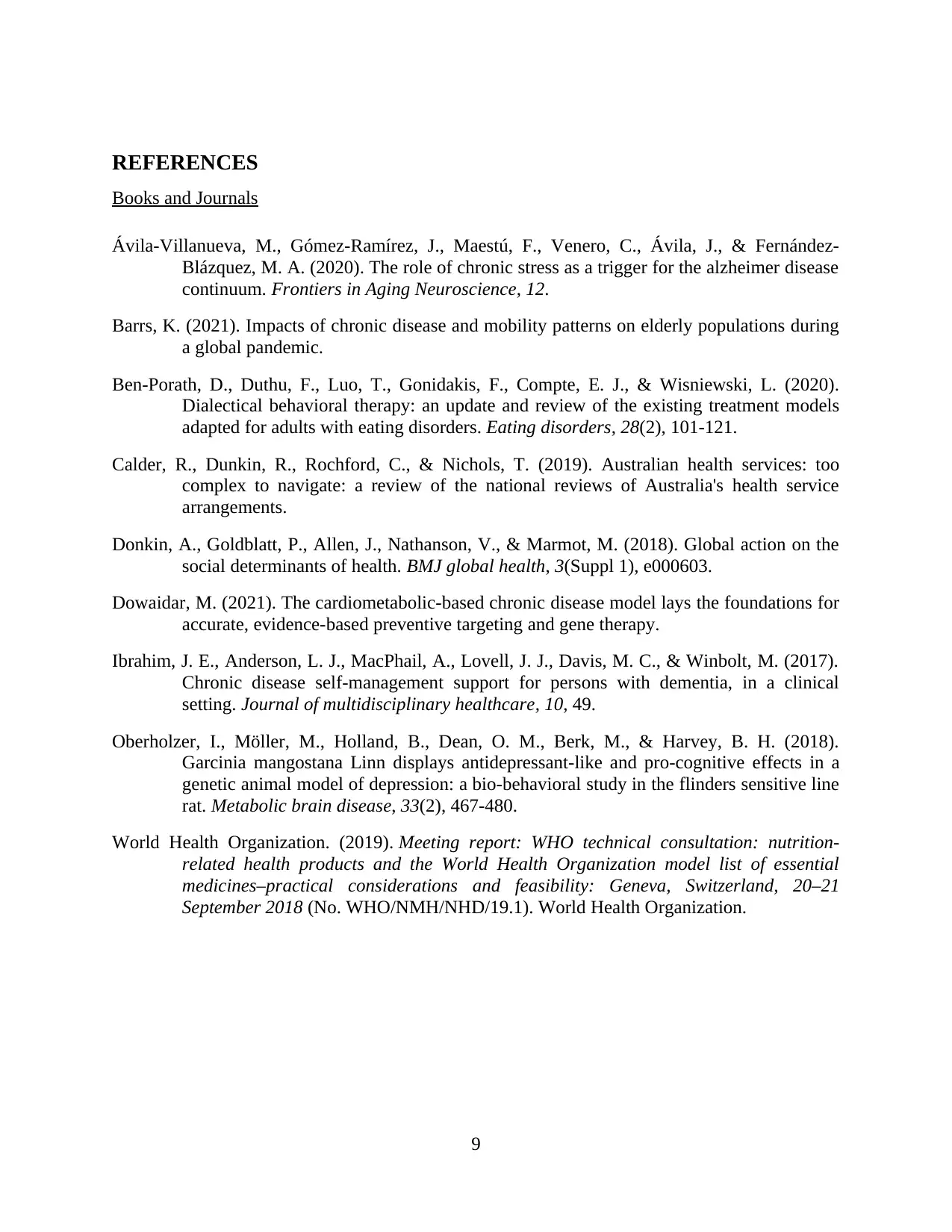
REFERENCES
Books and Journals
Ávila-Villanueva, M., Gómez-Ramírez, J., Maestú, F., Venero, C., Ávila, J., & Fernández-
Blázquez, M. A. (2020). The role of chronic stress as a trigger for the alzheimer disease
continuum. Frontiers in Aging Neuroscience, 12.
Barrs, K. (2021). Impacts of chronic disease and mobility patterns on elderly populations during
a global pandemic.
Ben-Porath, D., Duthu, F., Luo, T., Gonidakis, F., Compte, E. J., & Wisniewski, L. (2020).
Dialectical behavioral therapy: an update and review of the existing treatment models
adapted for adults with eating disorders. Eating disorders, 28(2), 101-121.
Calder, R., Dunkin, R., Rochford, C., & Nichols, T. (2019). Australian health services: too
complex to navigate: a review of the national reviews of Australia's health service
arrangements.
Donkin, A., Goldblatt, P., Allen, J., Nathanson, V., & Marmot, M. (2018). Global action on the
social determinants of health. BMJ global health, 3(Suppl 1), e000603.
Dowaidar, M. (2021). The cardiometabolic-based chronic disease model lays the foundations for
accurate, evidence-based preventive targeting and gene therapy.
Ibrahim, J. E., Anderson, L. J., MacPhail, A., Lovell, J. J., Davis, M. C., & Winbolt, M. (2017).
Chronic disease self-management support for persons with dementia, in a clinical
setting. Journal of multidisciplinary healthcare, 10, 49.
Oberholzer, I., Möller, M., Holland, B., Dean, O. M., Berk, M., & Harvey, B. H. (2018).
Garcinia mangostana Linn displays antidepressant-like and pro-cognitive effects in a
genetic animal model of depression: a bio-behavioral study in the flinders sensitive line
rat. Metabolic brain disease, 33(2), 467-480.
World Health Organization. (2019). Meeting report: WHO technical consultation: nutrition-
related health products and the World Health Organization model list of essential
medicines–practical considerations and feasibility: Geneva, Switzerland, 20–21
September 2018 (No. WHO/NMH/NHD/19.1). World Health Organization.
9
Books and Journals
Ávila-Villanueva, M., Gómez-Ramírez, J., Maestú, F., Venero, C., Ávila, J., & Fernández-
Blázquez, M. A. (2020). The role of chronic stress as a trigger for the alzheimer disease
continuum. Frontiers in Aging Neuroscience, 12.
Barrs, K. (2021). Impacts of chronic disease and mobility patterns on elderly populations during
a global pandemic.
Ben-Porath, D., Duthu, F., Luo, T., Gonidakis, F., Compte, E. J., & Wisniewski, L. (2020).
Dialectical behavioral therapy: an update and review of the existing treatment models
adapted for adults with eating disorders. Eating disorders, 28(2), 101-121.
Calder, R., Dunkin, R., Rochford, C., & Nichols, T. (2019). Australian health services: too
complex to navigate: a review of the national reviews of Australia's health service
arrangements.
Donkin, A., Goldblatt, P., Allen, J., Nathanson, V., & Marmot, M. (2018). Global action on the
social determinants of health. BMJ global health, 3(Suppl 1), e000603.
Dowaidar, M. (2021). The cardiometabolic-based chronic disease model lays the foundations for
accurate, evidence-based preventive targeting and gene therapy.
Ibrahim, J. E., Anderson, L. J., MacPhail, A., Lovell, J. J., Davis, M. C., & Winbolt, M. (2017).
Chronic disease self-management support for persons with dementia, in a clinical
setting. Journal of multidisciplinary healthcare, 10, 49.
Oberholzer, I., Möller, M., Holland, B., Dean, O. M., Berk, M., & Harvey, B. H. (2018).
Garcinia mangostana Linn displays antidepressant-like and pro-cognitive effects in a
genetic animal model of depression: a bio-behavioral study in the flinders sensitive line
rat. Metabolic brain disease, 33(2), 467-480.
World Health Organization. (2019). Meeting report: WHO technical consultation: nutrition-
related health products and the World Health Organization model list of essential
medicines–practical considerations and feasibility: Geneva, Switzerland, 20–21
September 2018 (No. WHO/NMH/NHD/19.1). World Health Organization.
9
⊘ This is a preview!⊘
Do you want full access?
Subscribe today to unlock all pages.

Trusted by 1+ million students worldwide
1 out of 9
Related Documents
Your All-in-One AI-Powered Toolkit for Academic Success.
+13062052269
info@desklib.com
Available 24*7 on WhatsApp / Email
![[object Object]](/_next/static/media/star-bottom.7253800d.svg)
Unlock your academic potential
Copyright © 2020–2025 A2Z Services. All Rights Reserved. Developed and managed by ZUCOL.





